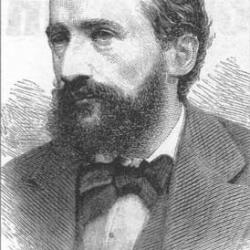Johannes Zukertort

Bio
Johannes Zukertort was a German and Polish chess master. In the 1870s and 1880s he was considered one of the top players in the world, as he had defeated multiple strong masters in matches. Zukertort's biggest accomplishment was winning the historical 1883 London tournament ahead of the world's best players, including Wilhelm Steinitz. After winning this tournament, Zukertort was considered by many to be the strongest player in the world.
Style
Zukertort's style was very similar to almost every player from the 1860s through the 1880s—aggressive and tactical. Much like Paul Morphy, Zukertort was adept at complicated attacks and flashy sacrifices. Zukertort was known to play openings that were not popular during his times (e.g., 1.c4 and 1.Nf3) and would also play semi-closed positions more often than a lot of his contemporaries (who preferred open positions). In this beautiful attacking game from Zukertort, he sacrifices his queen and rook very quickly to checkmate the black king on e5!
Early Chess Career
Zukertort learned to play chess at the relatively late age of 19. He did not have instant success, but he became friends with Adolf Anderssen (one of the best players in the world at that time). Zukertort trained with Anderssen for a few years and improved greatly. In 1866 he defeated Anderssen in a match. In the following game from this period, Zukertort sacrifices a knight and then a queen to deliver mate in just 12 moves! When was the last time you saw a world-class player be checkmated in 12 moves?
In 1868 Anderssen won the rematch against Zukertort, and this set the stage for their third and final match. In 1871 Zukertort convincingly defeated Anderssen by a score of 5-2. This victory led to many opportunities for Zukertort, who was now considered a world-class player. In 1872 Zukertort would face Wilhelm Steinitz in a match for the first time.

World-Class Player
At this point, Steinitz was recognized as the strongest player in the world and was undefeated in match play. Steinitz soundly defeated Zukertort by a score of 9-3. Zukertort shook off the loss to Steinitz and placed third in the 1872 London tournament. In the following game from 1872, Zukertort gave knight odds to Count de Kostaki Epoureano. Starting the game down a knight did not stop Zukertort from unleashing a memorable attack full of sacrifices!
Zukertort continued his tournament success in the late 1870s. In 1877 he won the Cologne tournament and placed second in Leipzig. In 1878 he tied for first place with Szymon Winawer (a world-class Polish master) in the Paris tournament. In 1881 he finished in second place in the Berlin tournament. In this same year, Zukertort would play a match against the English master and world-class player, Joseph Blackburne. Zukertort convincingly won this match by a score of 8.5-4.5.
In 1883 Zukertort achieved his greatest success by winning the London tournament. He started with a staggering score of 22/23! With three rounds left to go, he had already won the tournament (and lost the final three rounds). He finished with a score of 22/26, ahead of Steinitz, Blackburne, Mikhail Chigorin, Winawer, Henry Bird and others. In the following example of Zukertort's play in the 1883 London tournament, he launches an incredible attack that forces Chigorin (a world-class Soviet master) to resign after his king is chased from g1 all the way to c4!
First Official World Championship Match
Zukertort's victory in the 1883 London tournament made it clear to the chess world that he and Steinitz were the two strongest players in the world. After a few years of negotiating, Steinitz and Zukertort agreed to a historic match: the first official world championship match of 1886. The tournament would take place in New York, St. Louis and New Orleans. The first player to win 10 games would be rewarded with the title of world champion.

Zukertort began the match with a bang, winning four of the first five games in New York. Nowadays a 4-1 lead in a match would be considered game over—but this was not the case for the first official world championship! After New York, the tournament moved to St. Louis for the next four games. Steinitz won three games here and brought the match to a level score of four wins each (with one draw). The final 11 games of the tournament would be played in New Orleans, and momentum was on Steinitz's side. Zukertort lost six of the final 11 games and ultimately lost by a score of 12.5-7.5.
Here is Zukertort's round-two win from the first official world championship that displays his tactical prowess. Zukertort begins with a kingside attack and then creates a passed d-pawn. Steinitz is unable to handle the threats against his king as well as the passed pawn and is forced to resign.
Legacy
After the 1886 world championship match, Zukertort continued to play in tournaments, but his play began to deteriorate as his medical condition worsened. He would pass away from a heart attack in 1888 at the age of 45. Zukertort will always be best known as a participant in the first official world championship match, but he should also be remembered for his brilliant combinations and fantastic attacking abilities. The sacrifices displayed in the selected games alone are noteworthy and instructive.
Zukertort's games are still studied in books, videos and articles today. He continues to have a cult following of fanatical tacticians despite the fact that he passed away over 130 years ago. A chess legend, he is a member of a very small group of world-class players who have played for the world championship.


